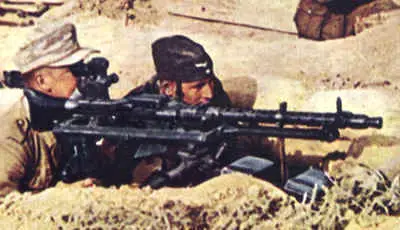Machine guns had been deadly during World War One. The same was true in World War Two. By the end of World War One, machine guns had radically changed how wars were fought. The supremacy of the cavalry had gone and scientific and industrial developments had become more important than élan.
 |
By 1939, the bulk of infantry training centred around the machine gun. In the inter-war years, machine guns had become more reliable even though the basics remained the same. Two types of machine guns had developed – heavy and light machine guns. Light machine guns were designed to be mobile and to move when its carrier moved. Heavy machine guns, while mobile, were more likely to be used when dug in for defensive purposes. They also had a greater rate of fire than a light machine gun that tended to rely on being magazine fed (like the British Bren gun) as opposed to being belt fed like a heavy machine gun. Heavy machine guns usually had better gun-sights on them and could sustain heavier and more accurate fire on an enemy position.
The Russians at the start of the war used the 12.7mm heavy machine gun. It was to remain standard issue throughout World War Two. It was gas-operated and used air to cool it. It weighed just under 79lbs (about 5.5 stone) and was moved on a two-wheeled mounting. The 12.7mm gun was over 60 inches in length and had a rate of fire of between 540 and 600 rounds per minutes (rpm).
The German 7.92mm MG-34, pictured above, combined aspects of both light and heavy machine guns. The 7.92 could be used on a tripod or on a bipod – depending on the circumstances. The machine gun weighed just over 26lbs with a bipod and 43lbs on a tripod. It was 48 inches in length. It had a rate of fire of between 800 and 900 rounds per minute.
The main US heavy machine gun was the formidable Browning .50-inch. Not only was the Browning used as a machine gun by infantry, it was also used as a standard anti-aircraft gun. It weighed 82lbs and was 65 inches in length. It had a rate of fire of 450 rpm.
The standard Japanese heavy machine gun was the 7.7mm Type 99-1. This was designed on the French Hotchkiss design and weighed in at 70lbs when used with a tripod. It was just over 42 inches in length. It had a rate of fire of 550 rpm.
The standard British heavy machine gun in World War Two was the tried and tested .303 inch Vickers. The Vickers may have been blooded in World War One but it had a reputation for being highly reliable. In one pre-war experiment, one Vickers fired non-stop (except for reloading) for seven days. It used water to keep it cooled via a steam-condensing radiator. It weighed in at 40lb with its tripod weighing an additional 50lb. Its overall length was 43 inches and it had a rate of fire of 450 to 550 rpm.
Related Posts
- Machine guns inflicted appalling casualties on both war fronts in World War One. Men who went over-the-top in trenches stood little chance when the enemy…